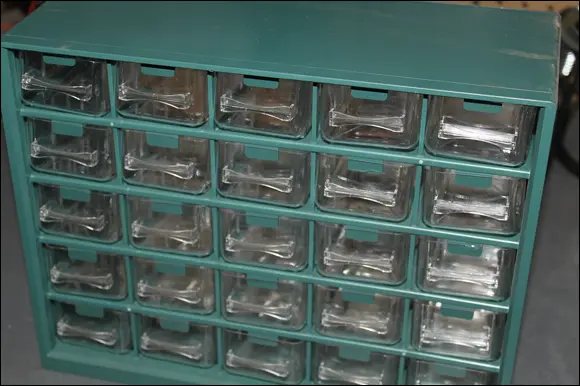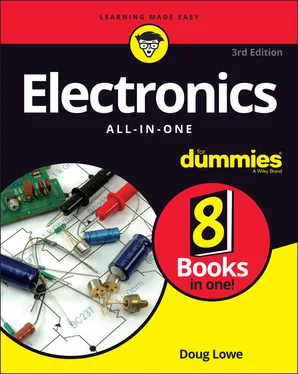Doug Lowe - Electronics All-in-One For Dummies
Здесь есть возможность читать онлайн «Doug Lowe - Electronics All-in-One For Dummies» — ознакомительный отрывок электронной книги совершенно бесплатно, а после прочтения отрывка купить полную версию. В некоторых случаях можно слушать аудио, скачать через торрент в формате fb2 и присутствует краткое содержание. Жанр: unrecognised, на английском языке. Описание произведения, (предисловие) а так же отзывы посетителей доступны на портале библиотеки ЛибКат.
- Название:Electronics All-in-One For Dummies
- Автор:
- Жанр:
- Год:неизвестен
- ISBN:нет данных
- Рейтинг книги:5 / 5. Голосов: 1
-
Избранное:Добавить в избранное
- Отзывы:
-
Ваша оценка:
- 100
- 1
- 2
- 3
- 4
- 5
Electronics All-in-One For Dummies: краткое содержание, описание и аннотация
Предлагаем к чтению аннотацию, описание, краткое содержание или предисловие (зависит от того, что написал сам автор книги «Electronics All-in-One For Dummies»). Если вы не нашли необходимую информацию о книге — напишите в комментариях, мы постараемся отыскать её.
Electronics All-in-One For Dummies,
Electronics All-in-One For Dummies
Electronics All-in-One For Dummies — читать онлайн ознакомительный отрывок
Ниже представлен текст книги, разбитый по страницам. Система сохранения места последней прочитанной страницы, позволяет с удобством читать онлайн бесплатно книгу «Electronics All-in-One For Dummies», без необходимости каждый раз заново искать на чём Вы остановились. Поставьте закладку, и сможете в любой момент перейти на страницу, на которой закончили чтение.
Интервал:
Закладка:
Good lighting: The ideal lighting should be overhead instead of from the side or behind you. If possible, purchase an inexpensive fluorescent shop light and hang it directly over your work area. If your chosen spot doesn’t allow you to hang lights from overhead, the next best bet is a desk lamp that swings overhead, to bring light directly over your work.
A solid workbench: Initially, you can get by with something as simple as a card table or a small folding table. Eventually, though, you’ll want something more permanent and substantial. You can make yourself an excellent workbench from an old door set atop a pair of old file cabinets, or you can hit the yard sales on a Saturday morning in search of an inexpensive but sturdy office desk. If your only option for your workbench is your kitchen table, go to your local big box hardware store and buy a 24-inch square piece of ⅝-inch plywood. This will serve as a good solid work surface and protect your kitchen table until you can acquire a real workbench.
Comfortable seating: If your workbench is a folding table or desk, the best seating is a good office chair. However, many workbenches stand 4 to 6 inches taller than desk height. This allows you to work comfortably while standing. If your workbench is tall, you’ll need to get a seat of the correct height. You can purchase a bench stool from a hardware store, or you can shop the yard sales for a cheap bar stool.
Plenty of electricity: You will obviously need a source of electricity nearby as you build electronic projects. A standard 15-amp electrical outlet will provide enough current capacity, but it probably won’t provide enough electrical outlets for your needs. The easiest way to meet that need is to purchase several multi-outlet power strips and place them in convenient locations behind or on either side of your work area.
Plenty of storage: You’ll need a place to store your tools, supplies, and components. The ideal storage for hand tools is a small sheet of pegboard mounted on the wall right behind your workbench. Then, you can use hooks to hang your tools within easy reach. For larger tools, such as a drill or saw, built-in cabinets are best.For small parts, multicompartment storage boxes, shown in Figure 3-2, are best. I suggest you get one or two of these to store all the little components such as resistors, diodes, capacitors, transistors, and so on. If you get two boxes, get one that has a few larger compartments and another that has a greater number of smaller compartments. It’s also a good idea to keep a few small, shallow storage bins handy. These are especially useful for storing parts for the project you’re working on. It helps to keep your parts together in a shallow bin rather than having them scattered loose all over your work area.

FIGURE 3-2:Multicompartment storage boxes are ideal for storing small components.
Equipping Your Mad-Scientist Lab
Like any hobby, electronics has its own special tools and supplies. Fortunately, you don’t need to run out and buy everything all at once. But the more involved you get with the hobby, the more you will want to invest in a wide variety of quality tools and supplies. The following sections outline some of the essential stuff you’ll need at your disposal.
Basic hand tools
For starters, you’ll need a basic set of hand tools, similar to the assortment shown in Figure 3-3. Specifically, you’ll need these items:
Screwdrivers: Most electronic work is relatively small, so you don’t need huge, heavy-duty screwdrivers. But you should get yourself a good assortment of small- and medium-sized screwdrivers, both flat-blade and Phillips head.A set of jeweler’s screwdrivers is sometimes very useful. The swiveling knob on the top of each one makes it easy to hold the screwdriver in a precise position while turning the blade. FIGURE 3-3:Basic hand tools you’ll want to have.
Pliers: You will occasionally use standard flat-nosed pliers, but for most electronic work, you’ll depend on needle-nose pliers instead, which are especially adept at working with wires — bending and twisting them, pushing them through holes, and so on. Most needle-nose pliers also have a cutting edge that lets you use them as wire cutters.Get a small set of needle-nose pliers with thin jaws for working with small parts, and a larger set for bigger jobs.
Wire cutters: Although you can use needle-nose pliers to cut wire, you’ll want a few different types of wire cutters at your disposal as well. Get something heavy-duty for cutting thick wire, and something smaller for cutting small wire or component leads.
Wire strippers: Figure 3-4 shows two pieces of wire that I stripped (removed the insulation from). I stripped the one on top with a set of wire cutters and the one on the bottom with a set of wire strippers. Notice the crimping in the one at the top, at the spot where the insulation ends? That was caused by using just a bit too much pressure on the wire cutters. That crimp has created a weak spot in the wire that may eventually break.YOU GET WHAT YOU PAY FORWhen it comes to tools, the old mantra “you get what you pay for” is generally true. Good tools that are manufactured from the best materials and with the best quality fetch a premium price. Cheap tools are, well, cheap. The price range can be substantial. You can easily spend $20 or $25 on decent wire cutters, or you can buy cheap ones for $3 or $4.There are two main drawbacks to cheap tools. First, they don’t last. The business end of a cheap tool wears out very fast. Each time you cut a wire with a pair of $4 wire cutters, you ding the cutting blade a bit. Pretty soon, the cutters can barely cut through the wire. The second drawback of cheap tools is a consequence of the first: When tools wear out, they tend to damage the materials you use them on. For example, tightening a screw with a badly worn screwdriver can strip the screw. Likewise, attempting to loosen a tight nut with a worn-out wrench can strip the nut.There are a few situations in which I would endorse spending money on cheap tools. One is as a way of getting started in this fascinating hobby as inexpensively as possible. You can always start with cheap tools, and then replace them one by one with more expensive tools as your experience, confidence, love of the hobby, and budget increases. Another good reason to buy cheap tools is if you’re absentminded (like me) and tend to lose things. There’s not much point in buying expensive tools if you’re going to have to replace them every few months because you keep losing them! FIGURE 3-4:The wire on the top was stripped with wire cutters; the one on the bottom was stripped with a wire stripper. To avoid damaging your wires when you strip them, I suggest you purchase an inexpensive (under $10) wire stripping tool. You’ll thank me later.
Magnifying glasses
One of the most helpful items you can have in your tool arsenal is a good magnifying glass. After all, electronic stuff is small. Resistors, diodes, and transistors are downright tiny.
Actually, I suggest you have at least three types of magnifying glasses on hand:
A handheld magnifying glass to inspect solder joints, read the labels on small components, and so on.
A magnifying glass mounted on a base so that you can hold your work behind the glass. The best mounted glasses combine a light with the magnifying glass, so the object you’re magnifying is bright.
Magnifying goggles, which provide completely hands-free magnifying for delicate work. Ideally, the goggles should have lights mounted on them (see Figure 3-5).
Читать дальшеИнтервал:
Закладка:
Похожие книги на «Electronics All-in-One For Dummies»
Представляем Вашему вниманию похожие книги на «Electronics All-in-One For Dummies» списком для выбора. Мы отобрали схожую по названию и смыслу литературу в надежде предоставить читателям больше вариантов отыскать новые, интересные, ещё непрочитанные произведения.
Обсуждение, отзывы о книге «Electronics All-in-One For Dummies» и просто собственные мнения читателей. Оставьте ваши комментарии, напишите, что Вы думаете о произведении, его смысле или главных героях. Укажите что конкретно понравилось, а что нет, и почему Вы так считаете.












